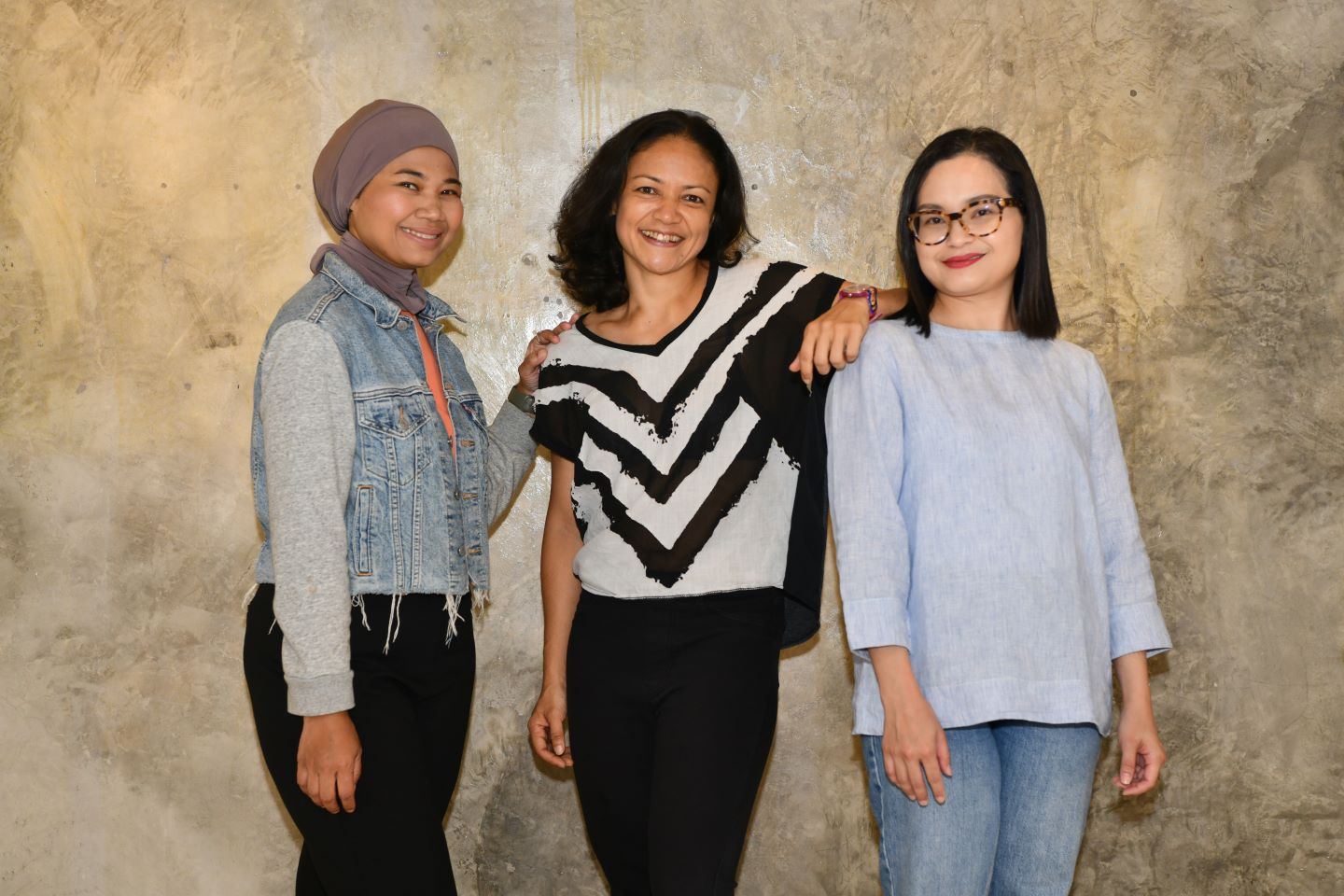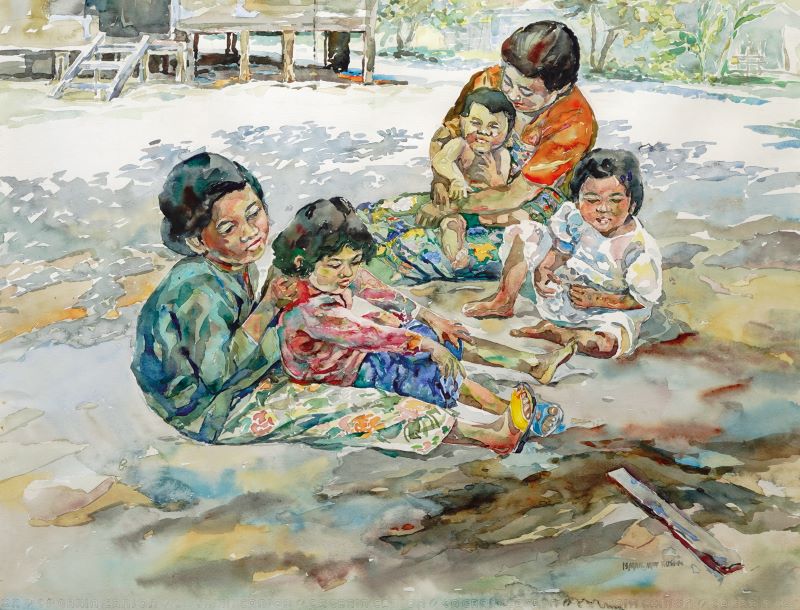
From left: Nazura Rahime, Sharmin Parameswaran and curator Sarah Abu Bakar (Photo: Shahrin Yahya/The Edge)
Most people would equate an art legacy with money. Sharmin Parameswaran and Nazura Rahime, who grew up visiting galleries and museums, often reluctantly, see it as a responsibility and an opportunity for selected pieces from their collections to go out where they may be appreciated.
“There are a lot of works, so do we continue to store them or start saying that they go where people will give them new life?
“Managing the collection and the space it takes up [involves] cost and things like cleaning and conservation. The easiest way out would be to sell it off, but that isn’t as easy as it sounds,” says Sharmin, whose late father, former diplomat Datuk N Parameswaran, was active in the local art scene in the 1980s.
Nazura is the daughter of Rahime Harun, who in 1983 founded AP Art Gallery with his wife Zarina Ariffin in Kuala Lumpur. The couple were artists, passionate about printmaking. Rahime died in 2008, and for about a decade, APAG was “put on hold”.
“I didn’t know what to do and did not want to think about it. I closed our galleries at Central Market, The Weld and the airport,” Nazura says. “But I’m the only child — who else is going to take care of the art? It took me a long time to accept that and plan what to do.”
She reopened APAG in 2018 on Sept 29 — her father’s birthday — and began documenting his art legacy, a long process given its size.
11._ismail_mat_husin_-_untitledjpg.jpg

Rahime and Parameswaran were friends and their daughters are holding an exhibition of 53 modern and contemporary works by 39 Malaysian artists from their collections. Bapaku Pulang, which opens at Temu House on Oct 7, is curated by Sarah Abu Bakar.
Sharmin, also a single child, has been curating and organising visual events since 2012. She met Nazura, owner of a production company, in the media industry, in which she has 17 years of experience. Both are about the same age and when the idea of a joint exhibition came up, it was easy to say yes.
What’s harder for Sharmin, who feels “inheriting an art legacy swings between daunting and exciting”, is going through her father’s collection to try understand his reasons and passion for collecting. He died last year and it has taken her since “to gather documentation and some semblance of what he had”. Bapaku Pulang is evocative and “just the start of this process”.
The exhibition title reminds Nazura of an old ditty she used to sing, Bapaku pulang dari kota, which conjures up images of a father travelling home with things he has bought, among them paintings.
Fine art consultant and curator Sarah had helped Parameswaran pick out pieces to put up for auction and knew Sharmin and Nazura. Her initial thought was to bring the new collectors together and connect with the audience.
“Bapaku Pulang is a nursery rhyme … I have children myself. There is also the other meaning of both fathers ‘coming back’ in the form of the artworks through their daughters. The exhibition is a celebration of what they have done for their children.”
Sharmin says, “This is just a sampling of what’s in our collections. We can expand each selection into other works, other stories, other exhibitions.”
She and Nazura grew up around art but did not like it. They now admit to being sentimental about certain pieces and are looking at how to curate or manage what they have. “Do I do it chronologically or by artist? Do I pull out certain artists [for a show]? Do I approach institutions or galleries? Or do I go to a curator with my list and ask, ‘Is there anything else you want to curate from it?’”
Both are open to donating art to public institutions but want to be certain it will resonate, be appreciated and well cared for. Getting to decide what they want to do with what they have is a “good problem, and yes, we can enjoy it”, Sharmin says.
bapaku_2.jpg

During the pandemic, Nazura brought several paintings out of the gallery and onto the streets by placing them on the back of a lorry that drove around a neighbourhood in Kuala Lumpur. She does not know what her father would say to that, “but there cannot be just one way of viewing art — hanging on a wall”, says this daughter who remembers there would be exhibitions to visit every weekend when she was little. She used to throw tantrums in front of the galleries!
Looking at the younger generation today, Sharmin reckons finding ways to introduce them to artists such as Tan Choon Ghee, or even landscape paintings, is a challenge.
Nazura, for whom Bapaku Pulang has been a process of discovery, feels having a narrative helps because “when you talk to a collector, he is able to tell you where and how he met an artist and why he bought their work. It’s different.
“Maybe my father told me why he got certain pieces. But I couldn’t care less when I was young.”
Before Sharmin got into art in 2012, she hardly talked to her dad about it. Also, because of his work and her studies abroad, they did not live in the same country from the time she was 12.
“What’s interesting for me is the way these artworks can now be re-presented and repackaged for the audience. Would I know the exact reason my dad took the time and trouble to collect them? Possibly not. Now that it’s there, how can I re-present it to Malaysian audiences or even those overseas?”
To those who can only think about the pair’s inheritance making them very rich, Sharmin says: “I think there is that. But you’ll be surprised that in the collection, there’s a lot of art we don’t even know what to do with. There might not even be a demand for it. What is sellable is a portion of it. The other portion, we will open it and go, ‘Why did he buy this?’”
Another question she has no answer to for now is: Do I devote all my time to the collection or do other projects because I have started?
An answer may not be necessary because Bapaku Pulang marks a turning point in how they view what is now theirs.
“Everyone sort of refers to the collection as ‘your dad’s’. In the title of the exhibition, we basically say, ‘Nazura and Sharmin’s collection’. That was something we decided to do, not without trepidation. I was a bit nervous. To be honest, we still don’t know what will come from that,” Sharmin shares.
“It is vulnerable as well because we are going out there and saying this is ours and people will be thinking, ‘You inherited it’.
“The good thing is we have each other. Nazura was saying it’s easier for us to do this exhibition because of that.”
“Eventually, obviously, the art is ours,” the latter pipes in. “We have to own it. Only when we accept that will it be easier to move around and manage. It also takes a lot of courage — it took me years to bring those pieces of work out.”
Having seen both their lists, Sarah thinks there is a lot more that can be done. Like a series of exhibitions based on an artist, as Sharmin suggests, or what Nazura did before: Get young artists to respond to a specific work and exhibit the results. “The possibilities are endless.”
Bapaku Pulang is on show from Oct 7 to 29 at Temu House, 49 Jalan 16/9e, Section 16, Petaling Jaya. There will be a panel discussion with Nazura Rahime and Sharmin Parameswaran on Oct 15, 3pm, and another with collectors on Oct 22, 3pm. Visit temu.my for details.
This article first appeared on Oct 9, 2023 in The Edge Malaysia.


